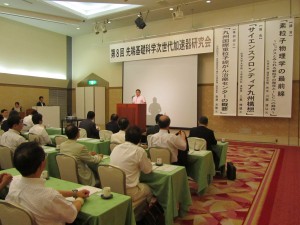
Yasushi Furukawa, governor of Saga prefecture, giving an opening address at the eighth meeting of the ILC study group
With the completion of the Technical Design Report just around the corner, activities surrounding the International Linear Collider have intensified in Japan. On 30 July, the eighth meeting of a study group in Kyushu, the southernmost island of Japan, was held in Saga prefecture.
The study group was established in 2007 to study the value and role of basic science research, its importance and its spin-off effects, with next-generation accelerators as the group’s primary subject through collaboration between industry, educational institutions and the administration in Kyushu area. Originally, this study group was lead primarily by Fukuoka and Saga prefectures. Since last January, the study group has expanded its activities to seven prefectures.
The main purpose of the meeting was to raise awareness of the value of basic science and to disseminate word about the ILC. The Sefuri mountains, one of the ILC candidate sites in Japan, straddles Fukuoka and Saga prefectures on Kyushu island.
In the group’s recent meeting, Nobuo Mishima, associate professor in urban engineering at Saga University, presented a report called “Science Frontier Kyushu.”
This report was prepared by two prefectures’ local governments, Kyushu Economic Federation, Kyushu University and Saga University. The effort is indicative of the prefectures’ aim in urban development to build a new international science city, which could be a hub of science research in the 21st century.
With their rich history, cultural diversity, and academic and industrial assets, the prefectures plan to invite the ILC as a core laboratory for their future international science city. In the report, following three visions are delivered:
- Development of human resources, which will be active internationally
- Contribution to the innovation of a new era
- Urban development to build an international city that uses various existing resources
Mishima introduced the 90 meeting attendees to the high-energy physics laboratory from the non-physicist’s point of view. He said that high-energy labs in the world won the confidence from community residents because they actively disclosed information and provided an opportunity to visit the facilities. He said that these labs have given rise to local pride.
He also pointed out issues that need to be addressed, such as the improvement of a system to accept foreign nationals, provision of present living climate or regional facilities. If Kyushu hosted the ILC, the prefecture would need housing, schools, and hospitals to provide untroubled living conditions for foreign researchers and their families. They would also need to provide various vocational benefits such as insurance and pensions, as well as visas. “The ILC would become an international infrastructure that could sustain the or era of a shrinking world,” Mishima said. “I expect the ILC to provide a spark for national and regional pride and dreams.”
The meeting also included two other talks and a visit to accelerator facilities in the Kyushu area. Kiyotomo Kawagoe, professor at Kyushu University, explained for attendees the LHC experiment and the recent discovery of the Higgs-like particle.
Mitsutaka Kanazawa from SAGA HIMAT (Heavy Ion Medical Accelerator in Tosu), the first privately founded heavy-ion beam therapy facility in Japan, also addressed attendees. They visited the ion therapy facility, which will begin operations next spring.
Enthusiasm for the ILC in Kyushu goes beyond government officials; it also extends to educators. In the opening speech of the meeting, Yasushi Furukawa, governor of Saga prefecture, introduced the prefecture’s educational programmes to meeting participants. Saga prefecture sends a delegation of high-school teachers to CERN every year. It so happened that this year’s programme was held from 1 to 21 July, during the time that LHC made its particle discovery announcement. “They were so happy to arrive upon the historical moment of the discovery of new particle,” Furkawa said. “I was a bit envious to hear their report.”
The report “Science Frontier Kyushu” will be used for policy proposals to the Japanese government.

Recent Comments